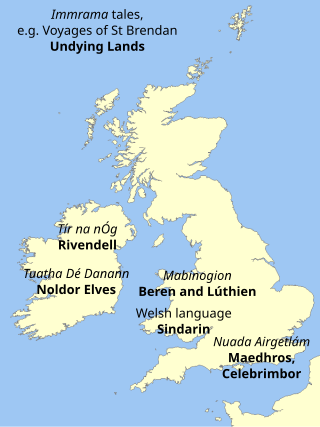
The Cirth is a semi‑artificial script, based on real‑life runic alphabets, one of several scripts invented by J. R. R. Tolkien for the constructed languages he devised and used in his works. Cirth is written with a capital letter when referring to the writing system; the letters themselves can be called cirth.
The Elvish languages of Middle-earth, constructed by J. R. R. Tolkien, include Quenya and Sindarin. These were the various languages spoken by the Elves of Middle-earth as they developed as a society throughout the Ages. In his pursuit for realism and in his love of language, Tolkien was especially fascinated with the development and evolution of language through time. Tolkien created two almost fully developed languages and a dozen more in various beginning stages as he studied and reproduced the way that language adapts and morphs. A philologist by profession, he spent much time on his constructed languages. In the collection of letters he had written, posthumously published by his son, Christopher Tolkien, he stated that he began stories set within this secondary world, the realm of Middle-earth, not with the characters or narrative as one would assume, but with a created set of languages. The stories and characters serve as conduits to make those languages come to life. Inventing language was always a crucial piece to Tolkien's mythology and world building. As Tolkien stated:
The invention of languages is the foundation. The 'stories' were made rather to provide a world for the languages than the reverse. To me a name comes first and the story follows.
The English philologist and author J. R. R. Tolkien created several constructed languages, mostly related to his fictional world of Middle-earth. Inventing languages, something that he called glossopoeia, was a lifelong occupation for Tolkien, starting in his teens.
In the fantasy of J. R. R. Tolkien, the Dwarves are a race inhabiting Middle-earth, the central continent of Arda in an imagined mythological past. They are based on the dwarfs of Germanic myths who were small humanoids that lived in mountains, practising mining, metallurgy, blacksmithing and jewellery. Tolkien described them as tough, warlike, and lovers of stone and craftsmanship.
Mithril is a fictional metal found in J. R. R. Tolkien's Middle-earth writings. It is described as resembling silver, but being stronger and lighter than steel. It was used to make armour, such as the helmets of the citadel guard of Minas Tirith, and ithildin alloy, used to decorate gateways with writing visible only by starlight or moonlight. Always extremely valuable, by the end of the Third Age it was beyond price, and only a few artefacts made of it remained in use.
The Black Speech is one of the fictional languages constructed by J. R. R. Tolkien for his legendarium, where it was spoken in the evil realm of Mordor. In the fiction, Tolkien describes the language as created by Sauron as a constructed language to be the sole language of all the servants of Mordor.
Tolkien fandom is an international, informal community of fans of the works of J. R. R. Tolkien, especially of the Middle-earth legendarium which includes The Hobbit, The Lord of the Rings, and The Silmarillion. The concept of Tolkien fandom as a specific type of fan subculture sprang up in the United States in the 1960s, in the context of the hippie movement, to the dismay of the author, who talked of "my deplorable cultus".
The works of J. R. R. Tolkien have generated a body of research covering many aspects of his fantasy writings. These encompass The Lord of the Rings and The Silmarillion, along with his legendarium that remained unpublished until after his death, and his constructed languages, especially the Elvish languages Quenya and Sindarin. Scholars from different disciplines have examined the linguistic and literary origins of Middle-earth, and have explored many aspects of his writings from Christianity to feminism and race.
J. R. R. Tolkien's fantasy books on Middle-earth, especially The Lord of the Rings and The Silmarillion, drew on a wide array of influences including language, Christianity, mythology, archaeology, ancient and modern literature, and personal experience. He was inspired primarily by his profession, philology; his work centred on the study of Old English literature, especially Beowulf, and he acknowledged its importance to his writings.
In the fictional world of J. R. R. Tolkien, Moria, also named Khazad-dûm, is an ancient subterranean complex in Middle-earth, comprising a vast labyrinthine network of tunnels, chambers, mines and halls under the Misty Mountains, with doors on both the western and the eastern sides of the mountain range. Moria is introduced in Tolkien's novel The Hobbit, and is a major scene of action in The Lord of the Rings.

Quenya is a constructed language, one of those devised by J. R. R. Tolkien for the Elves in his Middle-earth fiction.
Sindarin is one of the constructed languages devised by J. R. R. Tolkien for use in his fantasy stories set in Arda, primarily in Middle-earth. Sindarin is one of the many languages spoken by the Elves. The word Sindarin is a Quenya word.
Khuzdul is a fictional language created by J. R. R. Tolkien, one of the languages of Middle-earth, specifically the secret and private language of the Dwarves. He based its structure and phonology on Semitic languages, primarily Hebrew, with triconsonantal roots of words. Very little is known of the grammar.

Tolkien's artwork was a key element of his creativity from the time when he began to write fiction. The philologist and author J. R. R. Tolkien prepared a wide variety of materials to support his fiction, including illustrations for his Middle-earth fantasy books, facsimile artefacts, more or less "picturesque" maps, calligraphy, and sketches and paintings from life. Some of his artworks combined several of these elements.
J. R. R. Tolkien was both a philologist and an author of high fantasy. He had a private theory that the sound of words was directly connected to their meaning, and that certain sounds were inherently beautiful. Scholars believe he intentionally chose words and names in his constructed Middle-earth languages to create feelings such as of beauty, longing, and strangeness. Tolkien stated that he wrote his stories to provide a setting for his languages, rather than the other way around. Tolkien constructed languages for the Elves to sound pleasant, and the Black Speech of the evil land of Mordor to sound harsh; poetry suitable for various peoples of his invented world of Middle-earth; and many place-names, chosen to convey the nature of each region. The theory is individual, but it was in the context of literary and artistic movements such as Vorticism, and earlier nonsense verse that stressed language and the sound of words, even when the words were apparently nonsense.

Tom Loback was an artist, known for his illustrations of characters from J. R. R. Tolkien's 1977 book The Silmarillion, his miniature figurines, and his public artworks in New York. He contributed also as a Tolkien scholar interested in Tolkien's constructed languages.

Anthony Appleyard worked at the University of Manchester Institute of Science and Technology, and was known as a Tolkien scholar specialising in Tolkien's constructed languages. His 1995 description of the Elvish language Quenya was the first to use the information published in The History of Middle-earth. This was criticised by the Tolkien scholar Carl F. Hostetter as trying to construct a single consistent language rather than accepting that Quenya changed over time, both in the real world as Tolkien continued to invent linguistic structures, and in the fictional history of Middle-earth as the Elvish languages changed and fragmented.

J. R. R. Tolkien derived the characters, stories, places, and languages of Middle-earth from many sources. Among these are the Celtic legends and languages, which for Tolkien were principally Irish and Welsh. He gave multiple conflicting reasons for his liking for Welsh. Tolkien stated directly that he had made use of Welsh phonology and grammar for his constructed Elvish language Sindarin. Scholars have identified multiple legends, both Irish and Welsh, as likely sources of some of Tolkien's stories and characters; thus for example the Noldorin Elves resemble the Irish Tuatha Dé Danann, while the tale of Beren and Lúthien parallels that of the Welsh Culhwch and Olwen. Tolkien chose Celtic names for the isolated settlement of Bree-land, to distinguish it from the Shire with its English names.

J. R. R. Tolkien included many elements in his Middle-earth writings, especially The Lord of the Rings, other than narrative text. These include artwork, calligraphy, chronologies, family trees, heraldry, languages, maps, poetry, proverbs, scripts, glossaries, prologues, and annotations. Scholars have stated that the use of these elements places Tolkien in the tradition of English antiquarianism.







